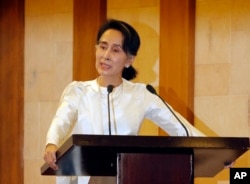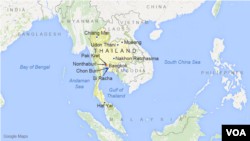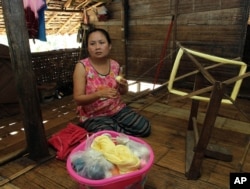Efforts to repatriate more than 98,000 ethnic Burmese refugees to Myanmar with United Nations support are slowly progressing, even as international donors cut funding to camps in Thailand where the refugees are living.
Humanitarian workers say the funding pressures come amid questions concerning security and inadequate infrastructure and health systems in southeast Myanmar after years of conflict.
The nine camps on the Thai border have been in place since the mid-1980s as refugees flooded into Thailand to escape conflict between armed ethnic armies and the Myanmar military.
But programs to repatriate the refugees have increased as Myanmar, also known as Burma, has moved to democracy after the election of the civilian government under Aung San Suu Kyi in 2015.
Funding and safety concerns
The government has pursued national reconciliation as well as cease-fire and peace agreements with the ethnic armies. But progress has been slow.
Saw Paul Sein Twa, executive director of the Karen Environmental and Social Action Network (KESAN) said the growing pressures on the refugees to leave the camps are being driven by funding cuts by international donors.
“The donors are jumping very fast. And what we want to see is an organized return where we work together, plan step by step. But what’s happening now is more like promoting the refugees return, like setting out some program with the Thai authorities and then the people who want to go back to go and register,” Sein Twa told VOA.
The Thai-based The Border Consortium (TBC), in its 2016 annual report, said reduced contributions were evident from Norway, Sweden, and the United States Agency for International Development’s Project for Local Empowerment (USAID-PLE).
Sein Twa said the chief concern is forcing people back without adequate cooperation.
“If the situation really comes to a time when there is no more support, then after that it will be chaotic,” he said.
Funding affects camp workers
The Irrawaddy newspaper recently reported that about 10,000 community workers in the nine refugee camps along the Thai border would face pay cuts because of the funding reductions.
The community workers manage the camps, deliver food and provide support staff, among other duties.
A United Nations High Commission for Refugees (UNHCR) program has been slow to start. Last October, the UNHCR announced a program for the repatriation of 71 returnees from the Nu Po and Tham Hin camps.
Some want to return
UNHCR regional spokesperson Vivian Tan said the repatriation was a pilot project of people who approached the UN for assistance.
“There is no specific time frame for voluntary return, though we stand ready to facilitate it as and when the refugees tell us they would like to go,” Tan said in an email to VOA.
She said a “few hundred” have indicated a readiness to return, and the UNHCR was coordinating with the Myanmar government.
Most still reluctant
Humanitarian workers say uncertainties within Myanmar continue to undermine the confidence of those seeking to return.
Sally Thompson, TBC executive director, said a lack of incentives, such as poor infrastructure, have left people cautious about returning to Myanmar.
“There is no pull factors in the southeast (of Myanmar). The peace process is going very slowly, the army is still in the villages in the southeast, people’s mistrust of the army goes very deep and it will take years for that to be turned around. People are looking for changes on the ground,” Thompson said.
Thompson said the southeast region of Myanmar faces a lack of health care, education and livelihoods. Those from Myanmar travel to Thailand seeking employment given the poor state of the regional economy, she said.
“What they are doing, they are keeping their options open. So they are looking at what might be possible. Some are making plans for the future; but at the moment they are still keeping a foot in the camp because that’s where they have got protection,” she said.
‘Desire to return’ slowly winning
But community workers are reported to be increasingly involved with meetings, travel and workshops in steps to repatriate the refugees.
International donor support has included funding led by the Nippon Foundation, a Japanese nonprofit organization, with plans to sponsor the construction of more than 1,000 homes.
Landmines, other impediments
The Karen Human Rights Group (KHRG) program director, Naw Htoo Htoo, said despite a cease-fire between the Karen National Liberation Army and the Myanmar armed forces, years of conflict has left the region scarred.
“Antipersonnel landmines, unexploded ordnances and other remnants of war — a great danger which has affected southeast Burma for decades — are still prominent after years of cease-fire,” Naw Htoo Htoo told local media.
The Myanmar Army recently offered to remove landmines in Karen State after an agreement with the Karen National Union (KNU).
But the landmines are just one issue for returnees. Access and land tenure are also issues, humanitarian workers say, especially the fear of land confiscation by developers.
Aid workers say the option of resettlement to third countries is also diminishing.
The International Organization for Migration (IOM) is overseeing resettlement.
Regional representative, Dana Graber Ladek, hopes countries outside the U.S., such as Australia, will take more refugees amid drastic declines in refugee resettlement to the U.S.
But aid workers say fewer people from the camps are likely to be resettled because those qualified for third countries have largely come forward.










